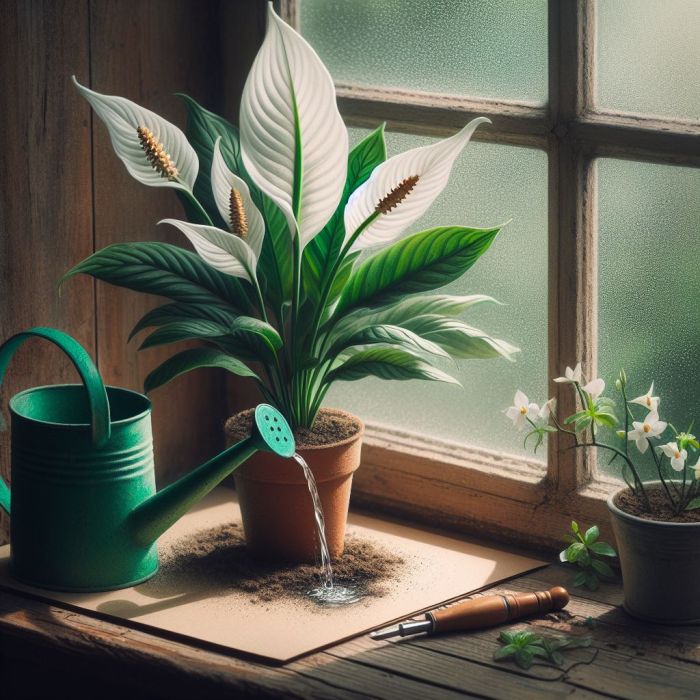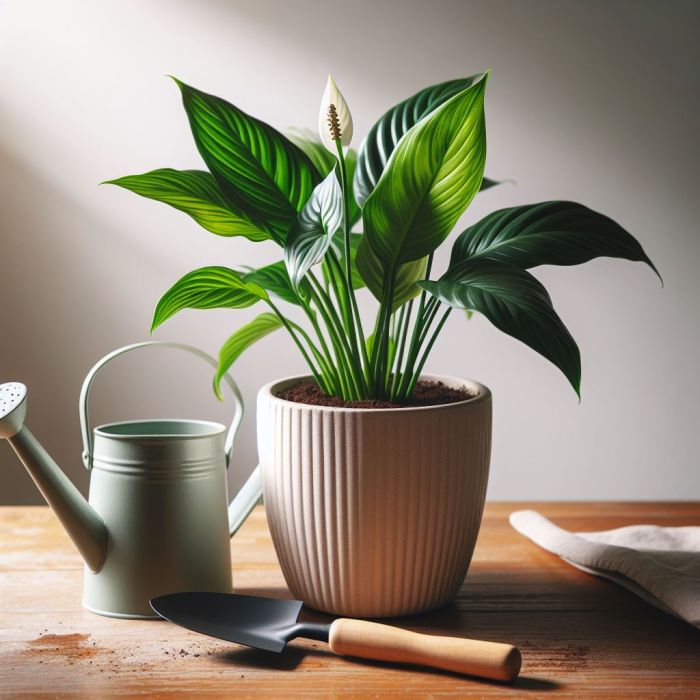Last updated on April 19th, 2024 at 08:30 am
Peace lilies, scientifically known as Spathiphyllum, are not only admired for their aesthetic appeal but also for their ability to improve indoor air quality. These plants are native to tropical regions of the Americas and thrive in warm, humid environments. Their glossy, dark green leaves provide a striking contrast to the delicate white flowers that emerge from their center, creating a captivating display.
Beyond their ornamental value, peace lilies are renowned for their air-purifying properties. They have been shown to effectively remove common indoor pollutants such as formaldehyde, benzene, and trichloroethylene, making them popular choices for homes and offices.
Contents
- 1 Why Are Peace Lily Leaves Turning Yellow?
- 2 FAQs
- 2.1 1. Why are my peace lily leaves turning yellow?
- 2.2 2. How can I prevent my peace lily leaves from turning yellow due to insufficient light exposure?
- 2.3 3. What should I do if my peace lily leaves turn yellow due to overwatering?
- 2.4 4. How do I address yellowing leaves caused by nutrient deficiencies?
- 2.5 5. Can extreme temperatures cause peace lily leaves to turn yellow?
- 2.6 6. What should I do if my peace lily leaves turn yellow due to insect infestations?
- 3 Author
Why Are Peace Lily Leaves Turning Yellow?
If you’ve observed your peace lily leaves turning yellow, it’s a clear indication of underlying issues that require proper attention. Yellowing leaves serve as a distress signal for peace lilies, suggesting a range of potential causes that demand careful consideration to identify the appropriate solution. Understanding these potential causes is essential for effectively addressing the problem and restoring your plant’s health.
1- Insufficient Light Exposure

One common reason for peace lily leaves turning yellow is insufficient light exposure. Inadequate light can impede the plant’s ability to photosynthesize, leading to a loss of chlorophyll and yellowing leaves.
Ensure your peace lily receives indirect, bright, but not harsh, light. Consider moving it to a location with filtered sunlight or placing it near a window without exposing it to direct sunlight.
2- Too Much Sunlight
Peace lilies, originating from tropical rainforests, thrive in dappled, indirect light rather than direct sunlight. Excessive sun exposure can lead to leaf burn, turning them brown and yellow. If you notice your peace lily leaves turning yellow, it could be a sign of sun damage. To keep your peace lily healthy, place it in a spot with indirect light, away from harsh sunlight.
3- Overwatering

Overwatering is a frequent mistake with peace lilies, as they prefer slightly moist soil rather than being constantly soaked. Excessive water can lead to root rot, causing the peace lily leaves to turn yellow.
Allow the top inch of soil to dry before watering your peace lily again. Ensure proper drainage in the pot and consider repotting if the soil is consistently waterlogged.
4- Underwatering
On the flip side, underwatering can also result in yellowing leaves of peace lilies. Peace lilies prefer consistent moisture, and letting the soil dry out completely can stress the plant, leading to yellowing leaves. If you observe peace lily leaves turning yellow, it’s essential to check the soil moisture and ensure a proper watering routine to maintain the plant’s health.
5- Nutrient Deficiency
Yellowing leaves may indicate a nutrient deficiency, particularly a lack of nitrogen, in peace lilies. When peace lily leaves turn yellow, it can be a sign that the plant is not receiving enough nutrients to support healthy growth. To address this issue, consider fertilizing your peace lily with a balanced fertilizer to replenish essential nutrients and promote vibrant green foliage.
6- Low humidity
Low humidity is another potential cause for peace lily leaves turning yellow. Originating from tropical regions, peace lilies thrive in environments with high humidity levels. When the air around them becomes too dry, it can stress the plant and lead to yellowing leaves.
By providing adequate humidity, you can help your peace lily maintain its health and vibrant green foliage, reducing the likelihood of yellowing leaves.
7- Poor Quality Water
The quality of water used for watering your peace lily can significantly impact its health and foliage color, potentially leading to peace lily leaves turning yellow. Tap water often contains minerals, such as chlorine and fluoride, which can accumulate in the soil over time and cause harm to the plant.
To combat the effects of poor quality water on peace lily leaves turning yellow, consider using filtered or distilled water for watering your plant. Alternatively, allow tap water to sit overnight in an open container to allow chlorine to dissipate before using it on your plants. By taking these steps, you can help ensure that your peace lily remains healthy and vibrant, with lush green foliage.
8- Root Bound
When a peace lily outgrows its container and becomes rootbound, it can lead to yellowing leaves. As the roots become cramped and overcrowded, they struggle to access water and nutrients, resulting in stress for the plant. This stress often manifests as yellowing leaves, indicating that the peace lily needs to be repotted into a larger container to allow its roots to spread and thrive. Regularly inspecting the roots and repotting as needed can help prevent this issue and maintain the health of your peace lily.
9- Extreme Temperatures
Extreme temperatures, whether excessively hot or cold, can cause stress to peace lilies, potentially resulting in peace lily leaves turning yellow. High temperatures can lead to leaf burn and dehydration, while cold drafts can cause chilling injury.
To prevent leaf yellowing due to extreme temperatures, ensure your peace lily is kept in a location with stable temperatures and away from drafts or direct heat sources. Regular monitoring of environmental conditions can help maintain the health and appearance of your peace lily’s foliage.
10- Natural Aging
Just as people age, so do plants, including peace lilies. As a peace lily matures, it may experience more frequent instances of yellowing leaves compared to younger plants.
In cases where the yellowing is attributed to the natural aging process, it’s advisable to remove the yellow leaves as you notice new growth emerging behind them. While you can’t prevent the plant from aging, you can assist it in thriving throughout its lifespan by ensuring optimal care and maintenance. Regularly removing spent foliage can help redirect the plant’s energy towards producing new growth, promoting overall health and vigor.
11- Insect Infestation
While peace lilies typically have robust natural defenses against pests, occasional infestations by mealybugs, aphids, or spider mites can occur. These pests, if left unchecked, can stress the plant and result in leaf discoloration, including yellowing.
To address pest infestations effectively, consider using neem oil on your peace lily. Neem oil is a natural and effective solution for controlling pests, and applying it to your plant can help keep these creepy crawlers at bay in the future. Regularly inspecting your peace lily for signs of pest activity and promptly treating any infestations can help maintain the plant’s health and prevent leaf discoloration.
FAQs
1. Why are my peace lily leaves turning yellow?
Peace lily leaves can turn yellow due to various reasons, including insufficient light exposure, overwatering, underwatering, nutrient deficiencies, low humidity, poor quality water, extreme temperatures, root-bound conditions, natural aging, or insect infestations.
2. How can I prevent my peace lily leaves from turning yellow due to insufficient light exposure?
Ensure your peace lily receives indirect, bright, but not harsh, light. Consider placing it near a window with filtered sunlight or providing artificial grow lights. Avoid exposing it to direct sunlight, which can lead to leaf burn.
3. What should I do if my peace lily leaves turn yellow due to overwatering?
Allow to dry the top of the soil before watering again peace lily. Ensure proper drainage in the pot and consider repotting the soil that remains consistently waterlogged.
4. How do I address yellowing leaves caused by nutrient deficiencies?
Fertilize peace lily with a balanced fertilizer to replenish essential nutrients, particularly nitrogen, which may be lacking. Follow the recommended dosage on the fertilizer packaging.
5. Can extreme temperatures cause peace lily leaves to turn yellow?
Yes, extreme temperatures, whether excessively hot or cold, can stress peace lilies and lead to leaf yellowing. Ensure your plant is kept in a location with stable temperatures away from drafts or direct heat sources.
6. What should I do if my peace lily leaves turn yellow due to insect infestations?
Treat peace lily with neem oil, a natural and effective solution for controlling pests like mealybugs, aphids, or spider mites. Regularly inspect the plant for the presence of pest activity and promptly treat infestations to prevent further leaf discoloration.
In conclusion, peace lily leaves turning yellow can be a distressing sight for plant owners, but understanding the various potential causes is the first step towards finding effective solutions. By addressing issues such as inadequate light exposure, over or underwatering, nutrient deficiencies, low humidity, poor water quality, extreme temperatures, root-bound conditions, natural aging, or insect infestations, you can help peace lily regain its health and vibrancy.
With proper care, attention, and timely intervention, peace lily can continue to thrive, gracing your indoor space with its lush green foliage and delicate white blooms for years to come.


1 thought on “11 Powerful Reasons Your Peace Lily Leaves Turning Yellow And How To Fix Them”